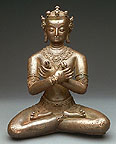
| Daniel L.Jackson |
| Sculpture of the Himalayas |
|
Himalayan sculpture is most often found to have come from two general regions: Nepal in the southern ranges and Tibet in the northern. Although the artworks
vary
in styles, they share a common purpose which is to serve as sacred objects assisting in worship. Because, until this day, this region has served as a stronghold for Esoteric Buddhism, these sculptures tend to be most often representations of the Buddha or, less often, of a Hindu deity.
Because Nepal is easily reached from India, Nepalese artists were exposed to the fluid and graceful Gupta style developed in the sixth century. Buddhism in Nepal was originally mostly Mahayana and later developed into Tantric, so the deities depicted are commonly ones with several heads and arms. Besides mastering casting and gilding of highly refined and detailed miniature images, Nepalese artists produced many works in stone, such as the Jalashayana Narayana (a twenty-one foot single stone sculpture depicting a manifestation of Vishnu lying atop of the World Serpent Ananta) which is still worshipped by both Buddhists and Hindus even today.
Due to Tibet's location, isolated by the ridges of Himalayas, Tibetan artwork remained well preserved from the seventeenth to the mid-twentieth century. The ideas of balance, multiplicity, and universality found in early Tibetan Buddhism and artwork soon became characteristics in Tibet' s own form Buddhism which developed, called Lamaism. Like the Nepalese, Tibetan sculptors also developed techniques for casting multi-armed, multi-headed images in bronze, silver, and gold. One of the most important Tibetan images is the Yab-yum (mother-father), depicting a male and female deity in sexual union, which symbolizes the union of the masculine principle of wisdom with the female principle of compassion. |
Lee, Sherman E. A History of Far Eastern Art, fifth edition. Prentice Hall, Inc. and Harry N. Abrams, Inc. pp. 132-137.
Ingo Lauf, Detlef. Tibetan Sacred Art. Berkeley, Cal.: Shambhala Publications, 1972.
Jackson, David P. and Janice A. Jackson. Tibetan Thangka Art, Methods and Materials. Berkeley, Cal. Shambhala Publications, 1984.
Lee, Sherman. A History of Far Eastern Art, 5th ed. Englewood Cliffs, N.J.:Prentice Hall, 1994.
Pal, Pratapaditya. Art of Tibet. Los Angeles: Los Angeles County Museum of Art Press, 1990. Dhamapala Center, School of Thangka Painting.
Online:
Asian Arts page
Page design by Chester A. Zemany
(Basic Design, City College of San Francisco)